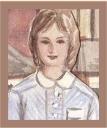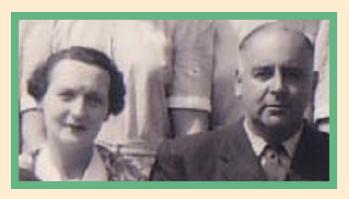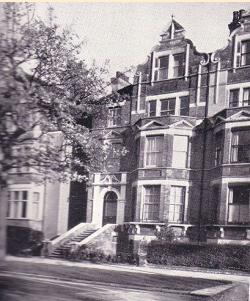1947
Mrs Winifred Frances Hasson, having acquired the school in December 1946 with ninety names on the register, took the title Headmistress and began the first term in January. Eighteen new pupils joined that term.
Mrs Hasson had previously been Headmistress of Tower Lodge School, Rugby. She brought with her three staff members from that school: Miss E M Lee, Miss Sampson and Edith the cook.
She had qualified as a kindergarten teacher by the Froebel system, and was a child psychologist. One of her favourite theories was that if you explained to a child why a rule was made she would obey it. It did not happen every time.
Her husband, Dudley Hasson, though not officially joint principal, took on this role, accepting many responsibilities and working indefatigably. He had been a major in the army, and for part of his service had been a quartermaster, an experience which proved useful in running the school.
The day the first term opened, in a bitterly cold January, Mrs Hasson was in the day-girls cloakroom to welcome them. Deep snow lay for weeks.
The changes made by the Hassons were not only because of post-war constraints, but with the deliberate intention of converting from worthy but outmoded Victorian traditions to a more modern style of education and behaviour. There was less supervision by the staff, with prefects taking on the responsibility of supervising the younger girls during breaks. Boarders were allowed to go shopping in town on Saturday mornings: the juniors with a mistress and the seniors on their own.
Films were shown every Sunday afternoon. Maureen O’Sullivan, 1947-53, has happy memories of ‘The Mark of Zorro’, a film starring Tyrone Power. The girls were not only in love with this heart-throb but tried to emulate the dashing way he left his mark by drawing a Z on trees and doors. Somebody acquired a water-pistol and squirted a Z onto the back of the English master when he turned to write on the blackboard.
The white table cloths were removed from the dining tables and replaced by easily wiped blue and white checked oil cloths. Maureen O’Sullivan confesses to having joined in the ‘improvements the girls made on the hanging sides by tearing them into strips and plaiting them. Soon they too had to be removed and replaced by nailed-on sheets of linoleum.
The school reverted to hockey after the de la Mare sisters preference for lacrosse. Swimming was introduced in the summer.
Every evening Mr and Mrs Hasson invited the borders to sit with them for half an hour before their respective bed-times to chat over the day’s activities. The younger ones came at 7.30, the older ones at 9.30. This generous gift of free time was appreciated by every girl who attended the ‘Evenings in the Study’. Granny Hasson, Dudley’s mother, would be there too, darning the boarders socks.
In the study stood the carved desk which had been presented to Miss E de la Mare to commemorate the move to Earl’s Avenue in 1903. The nieces had inherited it with the school but left it behind for Mrs Hasson, generously regarding it not as their own personal property but that of St Margaret’s headmistress.
When I joined the school in September 1947, Mrs Wicker’s ‘baby class’, which included a few little boys, was in the School Room next to the dining room. It could be divided into two by a screen, very likely the same one installed by Miss de la Mare the aunt. I discovered a hole in this screen, and used it for passing love-letters to Jeremy Fisher. I learnt to sing ‘Onward, Christian Soldiers and, without really understanding the words, thought it was the most wonderful tune in the world.
That September, the first of a new series of school magazines was produced, Vol.5 No.1, after a gap of eight years spanning the war. Though without photographs, it set the tone for future magazines with a list of prefects for the past and coming years, a report of Speech Day and the prize-winners, Miss Kennedy’s dancing display and the cricket matches against various boys schools, Brampton Down, the staff and the mothers, "many of them out of practice but who "put up a wonderful fight". There was a summary of the tennis and swimming seasons, diary notes of the year’s activities, an interesting article by Elizabeth Warren on the effects the war had on Folkestone, a girl’s impressions of her holiday trip to Holland, some notes on the science of biology by Miss Margaret Kerrigan, poems, jokes, notes by an old girl on the foundation and earlier years of the school, and a plea for contributions to the next magazine.
The Hassons had taken the school over at a favourable time. Folkestone was regaining its prosperity. Families who had left for the war were returning, and the town was expanding with newcomers. Shorncliffe Camp was still bringing military families to the town and many sent their daughters to St Margaret’s. One notable example was the
distinguished actress Carmen du Sautoy who spent a few years in the junior school in the late fifties. The Persian connection strengthened by receiving aregular inflow of pupils from the school at Awali in the Persian Gulf.
While sweets were still being rationed in the early post-war years, the girls were allowed to order their sweets through the school in units of two ounces to a total of one pound a month. The local sweet shop owner weighed all these minute amounts out individually: 2 ozs of chocolate liqueurs (everyone’s favourite), 2 ozs of peppermints and so on. When it all arrived at the school each month the girls clamoured for their orders and ate the lot as fast as possible.



